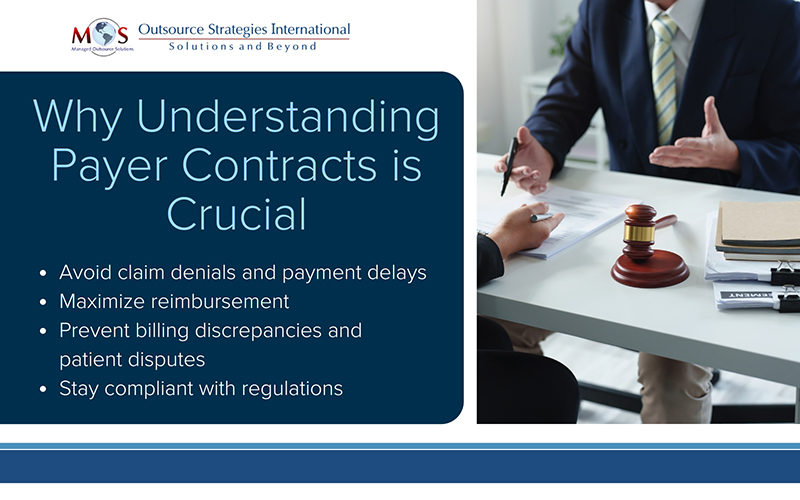Thoroughly understanding payer contracts is essential for avoiding claim denials, ensuring proper reimbursement, and maintaining a smooth patient experience. Imagine this scenario:
A cardiology practice treats a long-time patient for a routine follow-up and diagnostic testing. Confident that the services were covered under the patient’s insurance plan, the practice submitted the claim. However, they received a denial stating the procedures were “not covered” under the payer contract. Confused, the patient contacted the practice about why he now owed an unexpected balance.
On review, the billing team found that the contract with this payer had changed earlier in the year, restricting reimbursement for certain diagnostic tests. Since the practice hadn’t fully reviewed the updated payer contract, they were unprepared for the reimbursement changes, leaving both the physician and the patient frustrated.
This situation could have been prevented by outsourced billing solutions to experts who stay updated on payer contract changes and reimbursement policies.
This post will explain what payer contracts are, why understanding them is essential, common pitfalls in these contracts, and how to manage them effectively.
Simplify billing and payer contract management with our medical billing services!
Understanding the Key Components of Payer Contracts
Payers are entities that reimburse providers for services rendered and include government programs like Medicare and Medicaid, commercial insurance companies, and private payers. The health insurance company’s contract is at the crux of the payer-provider relationship. The payer contract or agreement is a legally binding agreement between a healthcare provider and payer, which states the terms under which the provider will deliver care to the payer’s members and how they will be reimbursed for those services.
Payment models are changing at a rapid pace and increasing in complexity, and physicians find it difficult to keep up with these changes. According to the 2023 World Commerce and Contracting Benchmark Report, organizations lose 8.6% of contract value due to inefficient contract management. Among the 750 business leaders surveyed, most expressed concerns over limited contract visibility, a direct result of poor contract management practices.
Understanding the components of payer contracts and effectively managing them can help healthcare providers maximize reimbursements.
Key components of healthcare payer contracts include: credentialing requirements, reimbursement rates, allowed amount, covered services, network requirements, provider obligations, and claim submission guidelines.
- Credentialing Requirements
In a payer contract, credentialing requirements ensure a healthcare provider is qualified and meets the insurance company’s standards to provide services to their members, involving verification of qualifications, experience, and licenses. While credentialing focuses on verifying qualifications, payer enrolment ensures the provider is correctly registered as a network participant and meets administrative requirements.
- Reimbursement Rates
Payers use different reimbursement methodologies and reimbursement structures. In the fee-for-service model, the physician receives fixed reimbursement amounts per item or service furnished, commonly negotiated in a physician participation agreement with the plan. Other reimbursement models include bundled payments (a single fee for all services related to a specific treatment), capitation (a set amount per patient, regardless of services), and value-based reimbursement (incentives for improving patient outcome.
Reimbursement differs based on factors such as the type of medical services, provider type (e.g., specialist vs. general practitioner), location and practice costs, and negotiated rates. Understanding reimbursement rates is essential for managing practice finances and ensuring appropriate payment for service rendered.
- Allowed Amount
According to the U.S. Department of Health and Human Services (HHS), the allowed amount in a payer contract represents the maximum reimbursement a payer will provide for a covered healthcare service. Some contracts may refer to this as the “eligible expense,” “payment allowance,” or “negotiated rate,” as noted by HHS. The allowed amount applies to services deemed covered or in-network, but it may not fully reimburse a provider’s charges. In such cases, patients may be responsible for paying the difference between the allowed amount and the provider’s billed charges.
Medicare determines allowed amounts for specific services through prospective payment systems based on the care setting and the Physician Fee Schedule. Private payers often use Medicare’s rates as a benchmark when establishing their own allowed amounts.
- Covered Services
Proper contracts clearly describe physician’s services covered by the contract, along with any limitations or exclusions, medical necessity and coverage rules for physician’s services, prior authorization process (manual vs. electronic) and policies for services or prescriptions, payment provisions, including penalties for late payments.
- Network Requirements
Network requirements are a crucial component of payer contracts, outlining the networks in which providers can participate and the credentialing criteria they must meet. Ensuring participation in the right network is essential for maximizing revenue and expanding patient volume.
As value-based care models grow, network requirements are becoming more complex. Different networks may be created for various payer products, and contracts often include credentialing language that dictates eligibility. However, some contracts may also grant payers the discretion to determine which providers can participate in specific networks.
To protect their practice, providers should ensure contract language does not allow arbitrary network selection by payers. Instead, network inclusion should be based solely on credentialing criteria, ensuring fairness and transparency in provider participation.
- Provider Obligations
In a payer contract, both the payer and the physician have specific obligations to ensure smooth reimbursement and compliance. While the payer’s obligation is mainly to provide timely reimbursement for covered services in accordance with regulations, the physician’s obligations entail delivering care according to the contract terms, complying with contractual terms – accepting negotiated rates, adhering to reimbursement limits, and following dispute resolution processes.
- Claim Submission Guidelines
Payer contracts outline the requirements a payer must follow to process and reimburse claims on time. These contracts also specify the provider’s responsibilities, such as submitting accurate and complete claims, to minimize denials and delays in payment. Payer contracts specify time limits for claim submission, outlining the period within which providers must submit claims to be eligible for reimbursement. Failure to submit claims within the allowed time frame can result in denied payments, leading to revenue loss. To prevent missed deadlines, providers should:
- Review contract terms for each payer’s submission window.
- Use automated billing systems to track and submit claims on time.
- Monitor claim rejections and resubmissions to stay within the allowable period.
Claim submission deadlines vary by payer but commonly range from 90 to 365 days from the date of service.
Common Mistakes in Payer Contracts That Lead to Claim Denials
- Unclear reimbursement terms: Vague language in contracts can lead to underpayments, making it crucial to define reimbursement rates clearly. For example, a contract may include a “lesser-of” clause stating that reimbursement will be the lesser of the provider’s billed charges, the contracted rate, or a percentage of Medicare allowable rates. This ambiguity allows payers to choose the lowest payment option, potentially resulting in reduced reimbursements for providers.
- Hidden clauses affecting provider compensation: Some contracts contain provisions that limit payments, impose fee reductions, or allow retroactive claim adjustments, impacting provider revenue.
- Frequent contract updates: Payers may update terms, reimbursement rates, or coverage policies, and failing to review these changes can lead to compliance issues or financial losses.
- Failure to negotiate favorable terms: Accepting standard contract terms without negotiation can result in lower reimbursements and restrictive conditions, reducing profitability.

How to Effectively Manage Payer Contracts
Before signing initial contracts or renewing existing contracts, here are some things to consider:
- Perform a comprehensive review of the contract. The American Medical Association recommends including the following items in your checklist when reviewing a payer contract:
- Parties, Plans and Product
- Physician Services
- Definitions of key terms (e.g., adverse change, affiliates, billed charges, clean claim, covered services, effective date, emergency care, enrollee/member/beneficiary, medical necessity, and payer).
- Credentialing Requirements
- Payment Provisions such as late payment/nonpayment, payment methodology, timeframe for claim submission, enrolee payments, overpayments, appeal, rates
- Coordination of Benefits
- Financial Data and Audit Requirements
- Policies, Procedures, Guidelines physicians must comply with
- Utilization and Quality Review
- Initial Term, Renewal and Termination
- Effect of Termination
- Assignment/Change of Control
- Indemnification
- Non-Solicitation
- Dispute Resolution
- Operational Considerations (such as if the payer partners with a third party company for any functionalities)
- Professional evaluation: Have an experienced attorney review the contract.
- Stay up to date on changes: Insurance payers have the authority to implement new policies or modify existing ones, impacting various aspects of healthcare coverage including reimbursement rates, coverage policies, and medical necessity requirements. Check payer websites regularly to track changes and sign up for any available payer notifications.
Stay Compliant and Maximize Reimbursement with Expert Support
Partnering with medical billing experts can help providers understand and negotiate payer contracts, maximize reimbursement, prevent denials, and operate a smooth revenue cycle. Medical billing outsourcing companies employ professionals who are well-versed in billing, coding, payer rules, and federal and state regulations. Their expertise ensures accuracy, minimizes errors, and reduces the likelihood of claim denials.
Don’t let inefficient billing processes hold you back.
Learn how our outsourcing solutions can boost your practice’s profitability!




